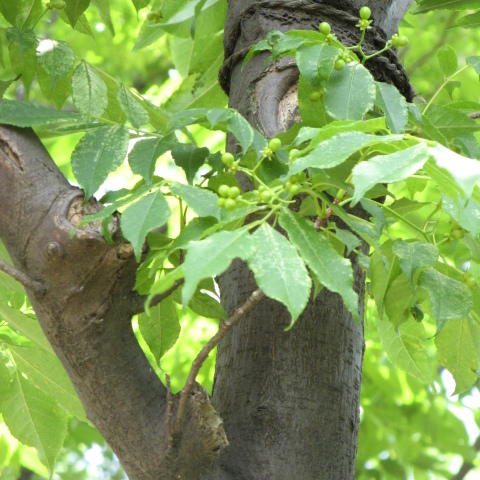Monoecious or dioecious trees or shrubs. Branches pithy, almost glabrous. Leaves imparipinnate; base of the petiole and usually the rachis nodes swollen, ± shrunken when dry; leaflets opposite or subopposite. Stipules early caducous, triangular, ovate or orbicular, sometimes seemingly absent, but present on innovations. Inflorescences axillary, longish peduncled, compound-cymose, unisexual. Bracts small, whether or not early caducous. Pedicels articulated in the lower half. Flowers 4-5-merous, unisexual or functionally female, the female ones usually twice as large as the ♂. Sepals small, free to united halfway up, persistent. Petals valvate or sub-valvate in bud, the mucronate tips incurved, persistent in female flowers, much longer than the sepals and sometimes accrescent. Stamens 4-5; anthers latrorse, emarginate at the top, split from the base to halfway up, basidorsifixed, versatile; filament inserted at the narrowed base of the disk (torus). Disk rather thick, sometimes accrescent in fruit. Carpels up to 7, free, vestigial or absent in ♂ flowers; styles connate except at the base, sometimes 1 or 2 free; stigmas free, rather long, filiform. Ovule 1, basal. Fruits 1-4, drupaceous; exocarp thin, fleshy, wrinkled when dry, endocarp hard. Seed with a broad hilum; placenta adaxial, basal; testa rather thick and hard; no endosperm.
More
Trees with bitter bark. Branches with a pith, glabrous. Leaves odd-pinnate; base of petiole or petiolule often dilated into a pulvinus that withers when dry; stipules early deciduous or persistent; leaflets opposite or nearly so; blades entire or serrate. Inflorescences axillary, cymose panicles. Flowers unisexual or polygamous, 4-or 5-merous; subtending bracts small or early deciduous; pedicel with lower half articulated. Sepals small, free or lower half connate, persistent. Petals valvate or nearly valvate in bud, apex shortly incurved, cuspidate, longer than sepals, persistent in females. Stamens 4 or 5, inserted at base of disk. Disk slightly thickened, entire or shallowly 4-or 5-lobed, sometimes dilate in fruit. Carpels 2-5, free, degenerate or rudimentary in males, each with a single ovule; style connate basally, apex free; stigma free. Fruit comprising one or more drupelike monocarps (each a druparium); exocarp thin, fleshy, wrinkled when dry; endocarp bony. Seeds with a broad hilum, exalbuminous; testa membranous, slightly thick and hard.

